- Home
- Mobiles
- Mobiles Reviews
- HTC Desire 500 review
HTC Desire 500 review
By Anupam Saxena | Updated: 27 November 2013 18:56 IST
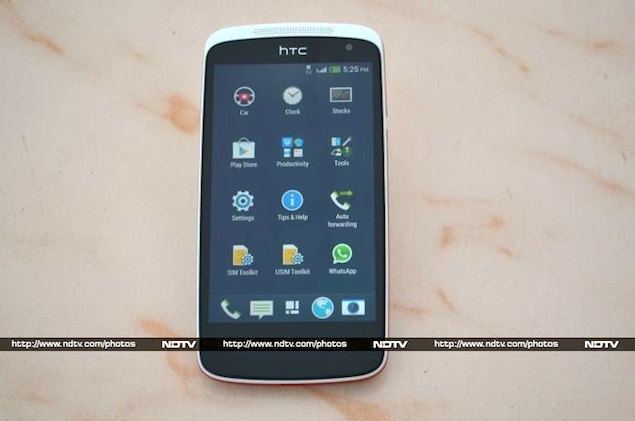
Click Here to Add Gadgets360 As A Trusted Source

Advertisement
The HTC Desire 500 is the Taiwanese handset giant's attempt to address the lower mid-range smartphone segment. The phone tries to pack in some major features of its elder siblings, the HTC Desire 600 and the HTC One, in a budget friendly compact plastic shell and relatively inferior hardware specifications.
Also giving it dual-SIM capability, HTC takes on the likes of Micromax, Karbonn and Lava (and even Sony) with the Desire 500, luring price sensitive users who want to use two connections on their smartphones.
Is the Desire 500 a good buy over smartphones from other device makers in the same price range? We try to answer this in our review.
Build/ Design
Cutting the crowd of 5-inch plus phablets, the HTC Desire 500 is a rather compact smartphone featuring a 4.3-inch display. The phone fits easily in one's hands and pockets, and is light in weight. It's made of good quality plastic and feels nice to hold.
The Desire 500 is available in two colour variants, Black and White. We got the latter as our review unit, with a touch of red on the edges and the back.The phone's construction reminded us of the Nokia Lumia 620, featuring a back panel cover that wraps around the front panel, with the former housing the phone's buttons.
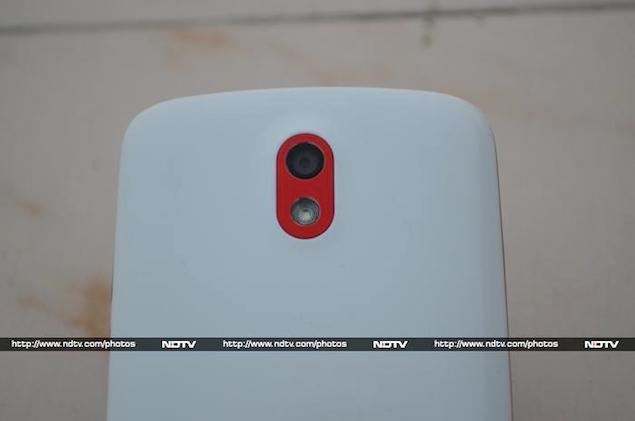 The front of the Desire 500 is dominated by its 4.3-inch WVGA display surrounded by a Black bezel. The phone doesn't sport a front speaker, unlike the HTC One, One mini and the Desire 600, but rather, its earpiece, which is placed above the display, looks like a front speaker. The two capacitive touch buttons for Back and Home sit below the display with the HTC branding in between, while the 1.6-megapixel front camera is located above the display, along with a notification LED.
The front of the Desire 500 is dominated by its 4.3-inch WVGA display surrounded by a Black bezel. The phone doesn't sport a front speaker, unlike the HTC One, One mini and the Desire 600, but rather, its earpiece, which is placed above the display, looks like a front speaker. The two capacitive touch buttons for Back and Home sit below the display with the HTC branding in between, while the 1.6-megapixel front camera is located above the display, along with a notification LED.
The side edge of the Desire 500 features a red coloured frame that runs across the entire phone but ends strategically at the top right edge with the two ends camouflaging the volume up and down buttons. Even the power / screen lock key is red in colour and sits at the top along with the 3.5mm headset jack. The keys don't really offer a good tactile feedback.
The Micro-USB port sits at the bottom of the Desire 500. There are no keys or ports on the left-hand side. The plastic cover sports a glossy finish at the back sporting some red coloured HTC branding and an 8-megapixel camera lens and LED flash (also featuring some red accents). The speaker grill is located towards the bottom.
Interestingly, the buttons are integrated with the Desire 500's cover, which means that it's hard to use them if the cover has been removed - hardly a typical use case, but worth pointing out nonetheless.
The back of the Desire 500 is prone to scratches and smudges though the glossy finish helps in concealing them. The phone doesn't feel very premium due to the glossy plastics but the quality of plastics used is better compared to Samsung phones.
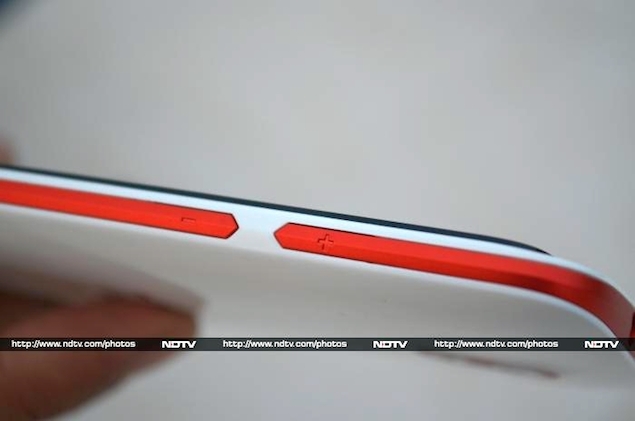 Removing the Desire 500's cover looks tricky at first but can be done by exerting some force on the back cover and pulling the cover from the bottom.
Removing the Desire 500's cover looks tricky at first but can be done by exerting some force on the back cover and pulling the cover from the bottom.
The two micro-SIM card slots and the microSD card slot are located above the battery compartment. All of these can be accessed without the need to remove the battery. However, you'll need to restart the phone if you insert a new SIM card.
Display
The HTC Desire 500 features a 4.3-inch TFT panel WVGA display with a resolution of 480x800 pixels and pixel density of 216ppi. We were a bit disappointed that HTC has not equipped the phone with at least a 720p display, especially considering the phone's price.
The display still looks better than the one seen on the Samsung Galaxy Grand but this has to do with the Desire 500's display not being very large, resulting in better pixel density.
The Desire 500 display's viewing angles were good, though. The screen is not very reflective and sunlight visibility was decent. Colours appeared to be vibrant and blacks looked deep.
Camera
The HTC Desire 500 sports an 8-megapixel rear camera lens which comes with auto-focus and an LED flash. The phone also includes a dedicated HTC ImageChip for quick processing of images and has Smart Flash, that offers a five-level flash that is automatically set based on the distance to the subject.
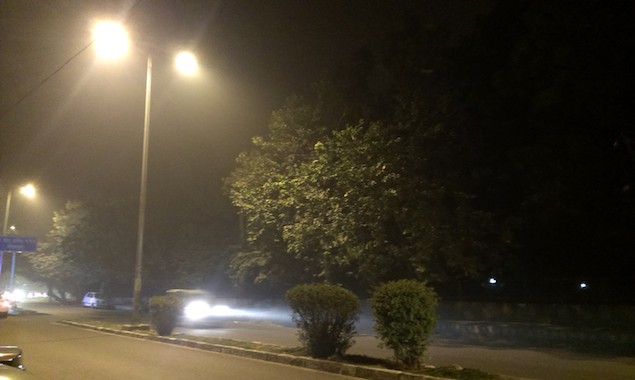 As with other Android devices from the company, HTC integrates its own Camera app, that allows users to select different scene settings (among Normal, Landscape, Portrait, Backlight, Night, Text and Macro) for still captures; switch between HDR, Sweep Panorama and Anti-shake modes, and choose the slow motion video mode. It also allows users to put a self timer (ranging from 2 to 10 seconds), select the resolution, video quality, review duration, image adjustments (for exposure, contrast, saturation and sharpness), ISO and White Balance settings. One can also choose to disable Continuous Shooting or restrict it to 20 frames.
As with other Android devices from the company, HTC integrates its own Camera app, that allows users to select different scene settings (among Normal, Landscape, Portrait, Backlight, Night, Text and Macro) for still captures; switch between HDR, Sweep Panorama and Anti-shake modes, and choose the slow motion video mode. It also allows users to put a self timer (ranging from 2 to 10 seconds), select the resolution, video quality, review duration, image adjustments (for exposure, contrast, saturation and sharpness), ISO and White Balance settings. One can also choose to disable Continuous Shooting or restrict it to 20 frames.
 In addition to the above, there are other options related to face and smile detection, geo-tagging, shutter sound and a grid interface. Interestingly, the camera app also offers lenses for adding effects like Sepia, Negative, Vintage, amongst others, even before one clicks a picture. Just like the HTC Butterfly, and HTC One, the Desire 500 also has a sightseeing mode, which simply means that if you lock the phone in the camera app, you'd find it open when you press the same key again (no need to unlock the screen.)
In addition to the above, there are other options related to face and smile detection, geo-tagging, shutter sound and a grid interface. Interestingly, the camera app also offers lenses for adding effects like Sepia, Negative, Vintage, amongst others, even before one clicks a picture. Just like the HTC Butterfly, and HTC One, the Desire 500 also has a sightseeing mode, which simply means that if you lock the phone in the camera app, you'd find it open when you press the same key again (no need to unlock the screen.)
The HTC Desire 500 doesn't include the HTC Zoe mode seen on the HTC One.
 The Desire 500 takes decent quality images in daylight and the amount of detail captured by the camera lens was satisfactory. Colour reproduction was pretty accurate.
The Desire 500 takes decent quality images in daylight and the amount of detail captured by the camera lens was satisfactory. Colour reproduction was pretty accurate.
Just like with the Desire 600, we did face issues trying to focus, especially while taking close up shots of objects, and noticed a very minor lag between pressing the shutter and the phone actually capturing an image, but the quality of photos compensated for these shortcomings.
Images taken indoors in artificial light were a bit soft and even grainy to a certain extent.
The Desire 500's BSI sensor does help in capturing images in low-light situations, however, the images shot in low-light with the night mode on had a high amount of noise similar to pictures shot with the Desire 600.
The camera can record video up to 720p resolution and we found the quality of the videos captured by the Desire 500 to be good.
The Desire 500's 1.6-megapixel camera also takes decent images and is suitable for self clicks and video chats.
Software/ Interface
The HTC Desire 500 runs Android 4.1.2 Jelly Bean, which is not the latest version of the OS considering that Google has released Android 4.3, and will soon announce Android 4.4 KitKat. As with other recent HTC Android phones, the phone comes with Sense 5, HTC's own UI layer that runs on top of Android. The new version of Sense was first seen on the HTC One.
While some people prefer stock Android over any kind of skinning, we feel that the Sense is one of the better skinning solutions. Skinning in Sense 5 is minimal compared to previous versions, and icons have been toned down, and appear flat.
The highlight of the Sense 5 UI is a home screen feed that the company likes to call BlinkFeed. You can select 'topics and services' for the BlinkFeed and it will push updates from them on the home screen. You can also select categories of interests. It also lets you select services such as Facebook, Twitter, Flickr, LinkedIn and Plurk, configure your account and receive updates on the Blink Feed.Updates are in the form of tiles that can be tapped to offer full text or videos. One can also share the update via social networks and email.
The Desire 500 offers BlinkFeed as the default home screen with time and weather information on top but you can easily select any other home screen as the default one. One can add up to five home screens including BlinkFeed as well as reduce the number of home screens to even one, though that screen has to be the BlinkFeed screen.
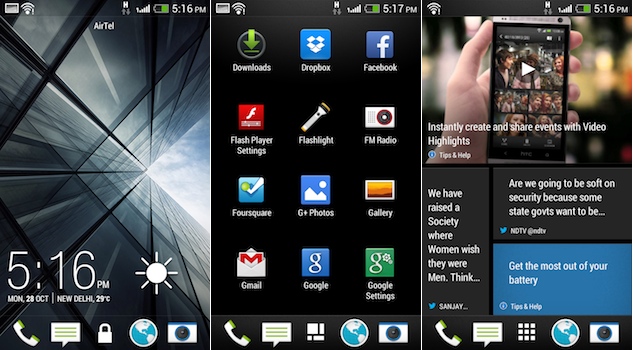 The default clock and weather information displays have been toned down to a flat minimalist white over black design on the Desire 500, though the conventional flip clocks and analog clocks are also available as widgets. The weather and clock info is also present in the menu/app launcher tray.
The default clock and weather information displays have been toned down to a flat minimalist white over black design on the Desire 500, though the conventional flip clocks and analog clocks are also available as widgets. The weather and clock info is also present in the menu/app launcher tray.
One can navigate the phone through the capacitive touch buttons for going to the Home screen and for going Back. HTC has got rid of the third 'Menu plus App Switcher' button on the Desire 500. The Home button on long press takes you to Google Now and on double tap takes you to the app switcher. You can change the double-tap speed of the Home button through settings.
We did miss the presence of the third button on the Desire 500, especially since there's no button in the middle on the phone. It takes some time getting used to the new arrangement, if you've been using any other Android phone for a significant amount of time.
HTC has also changed the app switcher UI with a flat app preview grid for up to 6 apps replacing the previous 3D UI. Apps can be dismissed by pushing preview windows out of the screen.
The HTC Desire 500 offers more or less the same software features that we've seen on the HTC One. For a detailed look, please read our HTC One review.
The Desire 500 doesn't include a TV Remote app that was present on the HTC One as the phone doesn't come with an IR Blaster. It also doesn't offer a Kid mode to enable selective access to some apps for kids and the Zoe camera mode unlike the HTC One.
Since the phone's stuck at Android 4.1, it also doesn't feature lock screen widgets. HTC has also not included toggles for frequently used controls (Wi-Fi, Bluetooth, Sound profiles, data and others) in the notifications tray.
HTC offers customised native apps for Music, Gallery, and Camera, among others.
We hope HTC releases an Android 4.2 update for the phone soon, to plug in the minor gaps in functionality and features.
Performance/ Battery Life
The HTC Desire 500 is powered by a 1.2GHz Qualcomm Snapdragon 200 quad-core processor with 1GB RAM, and an Adreno 203 chip for processing graphics. The phone has 4GB of internal storage, out of which only 1GB is available to the user. Storage is expandable up to 64GB through microSD cards.
Judging purely by the hardware specifications, the Desire 500 is anything but a high-end device.
The overall experience of navigation through the Desire 500's interface was decent and we did not experience much lag while launching apps, playing games or switching between apps. Having said that, we noticed that scrolling was not smooth while browsing the Play Store and using some apps, including Facebook and Twitter. Also, at times going back to the BlinkFeed or Home screen from an app caused a slight delay.
We were able to play games such as Temple Run, Subway Surfers and Asphalt 7 on the Desire 500 without any issues.
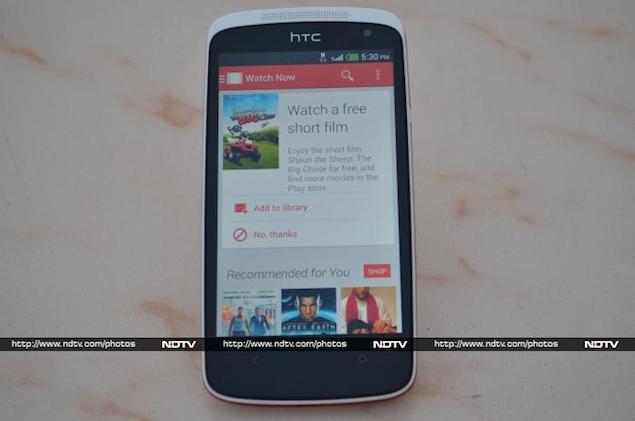 The HTC Desire 500 offers Chrome in addition to the default browser. The default browser also allows users to turn on Adobe flash for viewing Flash content. It also offers a reader mode for reading text heavy web pages.
The HTC Desire 500 offers Chrome in addition to the default browser. The default browser also allows users to turn on Adobe flash for viewing Flash content. It also offers a reader mode for reading text heavy web pages.
Unfortunately, we were not able to play full-HD videos on the Desire 500's native player (using a third-party app solves the issue). The sole rear speaker on the phone delivers decent quality sound at high volume levels but it gets muffled when the phone lies on its back. The phone also supports Beats audio, but only with headphones. The quality of sound output was good, overall.
Call quality was great and the Desire 500 is able to latch on to cellular networks even in weak signal areas.
The Desire 500 offers dual-SIM functionality with support for one 3G (WCDMA) SIM and a GSM (non-3G SIM). It offers active standby, which implies that if you're on a call on one SIM and get another call on the other one, you'll be notified of the call and the calling party will get a 'call waiting' indication.
The Desire 500 also offers FM radio and comes with NFC functionality for transferring content with other NFC-enabled phones. It also supports the DLNA protocol for wirelessly streaming media from the phone to a compatible TV or computer.
The HTC Desire 500 comes with an 1800mAh battery, and in our usage, it lasted us a full day. We charged the phone in the morning (at around 9 am), and with medium to heavy usage, including 1-1.5 hours of phone calls, two e-mail accounts with push notifications, playing some music, Twitter notifications and WhatsApp chats, the phone lasted a good 11-12 hours.
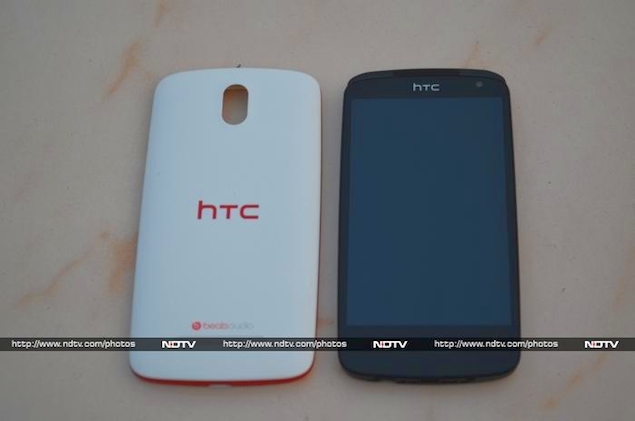 It's worth pointing out that we had turned off Wi-Fi and auto-brightness, and the Desire 500 was hooked to a 3G network with the screen brightness at the highest level. Altering these settings might help in running the phone for a longer duration, depending on your usage pattern.
It's worth pointing out that we had turned off Wi-Fi and auto-brightness, and the Desire 500 was hooked to a 3G network with the screen brightness at the highest level. Altering these settings might help in running the phone for a longer duration, depending on your usage pattern.
Verdict
At a price of Rs. 21,490, the HTC Desire 500 is a good all rounder if you're in the market for a compact Android phone that offers modern features and above average performance. However, we feel that HTC should have included a screen with a better resolution. Even the camera does not take good quality low-light shots and lacks support for full-HD video capture.
The recently launched Sony Xperia C and Micromax Canvas Turbo will surely give some competition to the phone in terms of hardware specifications. Both offer bigger screens and come almost at the same price point. We'd recommend that you wait for our reviews of the two new phones.
If you can spend a little more, the Nexus 4 (stocks could be limited) and the Lenovo K900 are good options, as well.
Overall, the Desire 500 is a good mid-range phone marred by a low resolution screen.

HTC Desire 500 in pictures
Also giving it dual-SIM capability, HTC takes on the likes of Micromax, Karbonn and Lava (and even Sony) with the Desire 500, luring price sensitive users who want to use two connections on their smartphones.
Is the Desire 500 a good buy over smartphones from other device makers in the same price range? We try to answer this in our review.
Build/ Design
Cutting the crowd of 5-inch plus phablets, the HTC Desire 500 is a rather compact smartphone featuring a 4.3-inch display. The phone fits easily in one's hands and pockets, and is light in weight. It's made of good quality plastic and feels nice to hold.
The Desire 500 is available in two colour variants, Black and White. We got the latter as our review unit, with a touch of red on the edges and the back.The phone's construction reminded us of the Nokia Lumia 620, featuring a back panel cover that wraps around the front panel, with the former housing the phone's buttons.
The side edge of the Desire 500 features a red coloured frame that runs across the entire phone but ends strategically at the top right edge with the two ends camouflaging the volume up and down buttons. Even the power / screen lock key is red in colour and sits at the top along with the 3.5mm headset jack. The keys don't really offer a good tactile feedback.
The Micro-USB port sits at the bottom of the Desire 500. There are no keys or ports on the left-hand side. The plastic cover sports a glossy finish at the back sporting some red coloured HTC branding and an 8-megapixel camera lens and LED flash (also featuring some red accents). The speaker grill is located towards the bottom.
Interestingly, the buttons are integrated with the Desire 500's cover, which means that it's hard to use them if the cover has been removed - hardly a typical use case, but worth pointing out nonetheless.
The back of the Desire 500 is prone to scratches and smudges though the glossy finish helps in concealing them. The phone doesn't feel very premium due to the glossy plastics but the quality of plastics used is better compared to Samsung phones.
The two micro-SIM card slots and the microSD card slot are located above the battery compartment. All of these can be accessed without the need to remove the battery. However, you'll need to restart the phone if you insert a new SIM card.
Display
The HTC Desire 500 features a 4.3-inch TFT panel WVGA display with a resolution of 480x800 pixels and pixel density of 216ppi. We were a bit disappointed that HTC has not equipped the phone with at least a 720p display, especially considering the phone's price.
The display still looks better than the one seen on the Samsung Galaxy Grand but this has to do with the Desire 500's display not being very large, resulting in better pixel density.
The Desire 500 display's viewing angles were good, though. The screen is not very reflective and sunlight visibility was decent. Colours appeared to be vibrant and blacks looked deep.
Camera
The HTC Desire 500 sports an 8-megapixel rear camera lens which comes with auto-focus and an LED flash. The phone also includes a dedicated HTC ImageChip for quick processing of images and has Smart Flash, that offers a five-level flash that is automatically set based on the distance to the subject.
The HTC Desire 500 doesn't include the HTC Zoe mode seen on the HTC One.
Just like with the Desire 600, we did face issues trying to focus, especially while taking close up shots of objects, and noticed a very minor lag between pressing the shutter and the phone actually capturing an image, but the quality of photos compensated for these shortcomings.
Images taken indoors in artificial light were a bit soft and even grainy to a certain extent.
The Desire 500's BSI sensor does help in capturing images in low-light situations, however, the images shot in low-light with the night mode on had a high amount of noise similar to pictures shot with the Desire 600.
The camera can record video up to 720p resolution and we found the quality of the videos captured by the Desire 500 to be good.
The Desire 500's 1.6-megapixel camera also takes decent images and is suitable for self clicks and video chats.
Software/ Interface
The HTC Desire 500 runs Android 4.1.2 Jelly Bean, which is not the latest version of the OS considering that Google has released Android 4.3, and will soon announce Android 4.4 KitKat. As with other recent HTC Android phones, the phone comes with Sense 5, HTC's own UI layer that runs on top of Android. The new version of Sense was first seen on the HTC One.
While some people prefer stock Android over any kind of skinning, we feel that the Sense is one of the better skinning solutions. Skinning in Sense 5 is minimal compared to previous versions, and icons have been toned down, and appear flat.
The highlight of the Sense 5 UI is a home screen feed that the company likes to call BlinkFeed. You can select 'topics and services' for the BlinkFeed and it will push updates from them on the home screen. You can also select categories of interests. It also lets you select services such as Facebook, Twitter, Flickr, LinkedIn and Plurk, configure your account and receive updates on the Blink Feed.Updates are in the form of tiles that can be tapped to offer full text or videos. One can also share the update via social networks and email.
The Desire 500 offers BlinkFeed as the default home screen with time and weather information on top but you can easily select any other home screen as the default one. One can add up to five home screens including BlinkFeed as well as reduce the number of home screens to even one, though that screen has to be the BlinkFeed screen.
One can navigate the phone through the capacitive touch buttons for going to the Home screen and for going Back. HTC has got rid of the third 'Menu plus App Switcher' button on the Desire 500. The Home button on long press takes you to Google Now and on double tap takes you to the app switcher. You can change the double-tap speed of the Home button through settings.
We did miss the presence of the third button on the Desire 500, especially since there's no button in the middle on the phone. It takes some time getting used to the new arrangement, if you've been using any other Android phone for a significant amount of time.
HTC has also changed the app switcher UI with a flat app preview grid for up to 6 apps replacing the previous 3D UI. Apps can be dismissed by pushing preview windows out of the screen.
The HTC Desire 500 offers more or less the same software features that we've seen on the HTC One. For a detailed look, please read our HTC One review.
The Desire 500 doesn't include a TV Remote app that was present on the HTC One as the phone doesn't come with an IR Blaster. It also doesn't offer a Kid mode to enable selective access to some apps for kids and the Zoe camera mode unlike the HTC One.
Since the phone's stuck at Android 4.1, it also doesn't feature lock screen widgets. HTC has also not included toggles for frequently used controls (Wi-Fi, Bluetooth, Sound profiles, data and others) in the notifications tray.
HTC offers customised native apps for Music, Gallery, and Camera, among others.
We hope HTC releases an Android 4.2 update for the phone soon, to plug in the minor gaps in functionality and features.
Performance/ Battery Life
The HTC Desire 500 is powered by a 1.2GHz Qualcomm Snapdragon 200 quad-core processor with 1GB RAM, and an Adreno 203 chip for processing graphics. The phone has 4GB of internal storage, out of which only 1GB is available to the user. Storage is expandable up to 64GB through microSD cards.
Judging purely by the hardware specifications, the Desire 500 is anything but a high-end device.
The overall experience of navigation through the Desire 500's interface was decent and we did not experience much lag while launching apps, playing games or switching between apps. Having said that, we noticed that scrolling was not smooth while browsing the Play Store and using some apps, including Facebook and Twitter. Also, at times going back to the BlinkFeed or Home screen from an app caused a slight delay.
We were able to play games such as Temple Run, Subway Surfers and Asphalt 7 on the Desire 500 without any issues.
Unfortunately, we were not able to play full-HD videos on the Desire 500's native player (using a third-party app solves the issue). The sole rear speaker on the phone delivers decent quality sound at high volume levels but it gets muffled when the phone lies on its back. The phone also supports Beats audio, but only with headphones. The quality of sound output was good, overall.
Call quality was great and the Desire 500 is able to latch on to cellular networks even in weak signal areas.
The Desire 500 offers dual-SIM functionality with support for one 3G (WCDMA) SIM and a GSM (non-3G SIM). It offers active standby, which implies that if you're on a call on one SIM and get another call on the other one, you'll be notified of the call and the calling party will get a 'call waiting' indication.
The Desire 500 also offers FM radio and comes with NFC functionality for transferring content with other NFC-enabled phones. It also supports the DLNA protocol for wirelessly streaming media from the phone to a compatible TV or computer.
The HTC Desire 500 comes with an 1800mAh battery, and in our usage, it lasted us a full day. We charged the phone in the morning (at around 9 am), and with medium to heavy usage, including 1-1.5 hours of phone calls, two e-mail accounts with push notifications, playing some music, Twitter notifications and WhatsApp chats, the phone lasted a good 11-12 hours.
Verdict
At a price of Rs. 21,490, the HTC Desire 500 is a good all rounder if you're in the market for a compact Android phone that offers modern features and above average performance. However, we feel that HTC should have included a screen with a better resolution. Even the camera does not take good quality low-light shots and lacks support for full-HD video capture.
The recently launched Sony Xperia C and Micromax Canvas Turbo will surely give some competition to the phone in terms of hardware specifications. Both offer bigger screens and come almost at the same price point. We'd recommend that you wait for our reviews of the two new phones.
If you can spend a little more, the Nexus 4 (stocks could be limited) and the Lenovo K900 are good options, as well.
Overall, the Desire 500 is a good mid-range phone marred by a low resolution screen.
HTC Desire 500 in pictures
Comments
Get your daily dose of tech news, reviews, and insights, in under 80 characters on Gadgets 360 Turbo. Connect with fellow tech lovers on our Forum. Follow us on X, Facebook, WhatsApp, Threads and Google News for instant updates. Catch all the action on our YouTube channel.
Further reading:
HTC, HTC Desire 500, HTC Desire 500 price, HTC Desire 500 price in India, HTC Desire 500 review, HTC Desire 500 specifications
Related Stories
Popular on Gadgets
- Samsung Galaxy Unpacked 2025
- ChatGPT
- Redmi Note 14 Pro+
- iPhone 16
- Apple Vision Pro
- Oneplus 12
- OnePlus Nord CE 3 Lite 5G
- iPhone 13
- Xiaomi 14 Pro
- Oppo Find N3
- Tecno Spark Go (2023)
- Realme V30
- Best Phones Under 25000
- Samsung Galaxy S24 Series
- Cryptocurrency
- iQoo 12
- Samsung Galaxy S24 Ultra
- Giottus
- Samsung Galaxy Z Flip 5
- Apple 'Scary Fast'
- Housefull 5
- GoPro Hero 12 Black Review
- Invincible Season 2
- JioGlass
- HD Ready TV
- Laptop Under 50000
- Smartwatch Under 10000
- Latest Mobile Phones
- Compare Phones
Latest Gadgets
- Xiaomi 17 Ultra Leica Edition
- Xiaomi 17 Ultra
- Huawei Nova 15
- Huawei Nova 15 Pro
- Huawei Nova 15 Ultra
- OnePlus 15R
- Realme Narzo 90x 5G
- Realme Narzo 90 5G
- Asus ProArt P16
- MacBook Pro 14-inch (M5, 2025)
- OPPO Pad Air 5
- Huawei MatePad 11.5 (2026)
- Huawei Watch 10th Anniversary Edition
- OnePlus Watch Lite
- Acerpure Nitro Z Series 100-inch QLED TV
- Samsung 43 Inch LED Ultra HD (4K) Smart TV (UA43UE81AFULXL)
- Asus ROG Ally
- Nintendo Switch Lite
- Haier 1.6 Ton 5 Star Inverter Split AC (HSU19G-MZAID5BN-INV)
- Haier 1.6 Ton 5 Star Inverter Split AC (HSU19G-MZAIM5BN-INV)
© Copyright Red Pixels Ventures Limited 2025. All rights reserved.

















